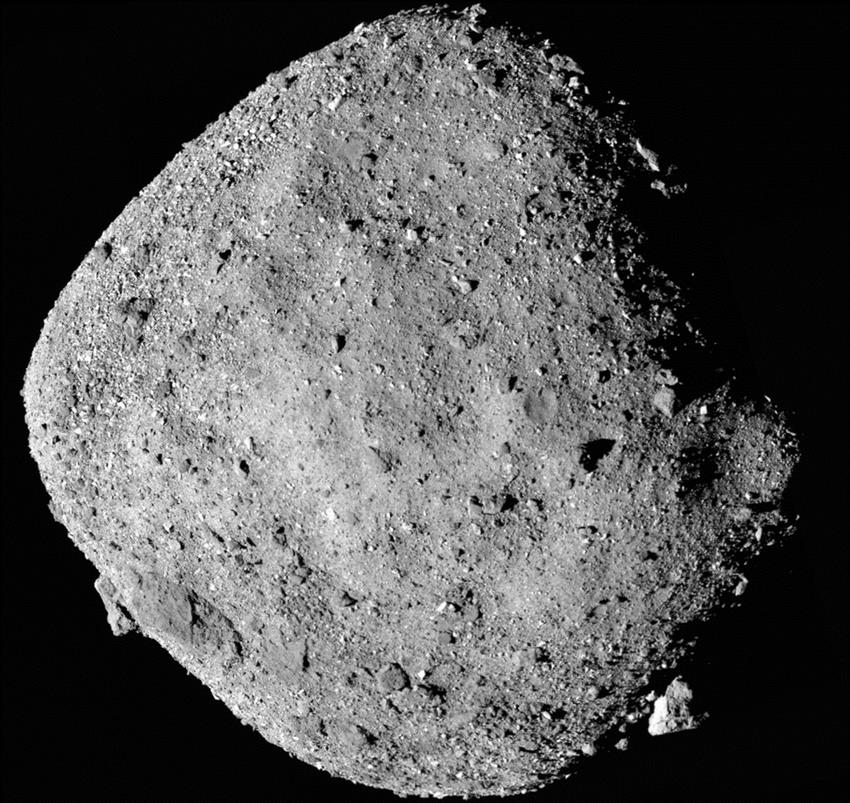Destination: Bennu
Asteroid Bennu was the target of the OSIRIS-REx mission, which collected a sample and sent it back to Earth for analysis. With over half a million known asteroids to choose from, why did scientists set their sights on Bennu?
Its location, size, composition, and scientific importance made Bennu the best place to send the OSIRIS-REx spacecraft on its cosmic journey.
Why go to Bennu?
OkThis video explores what circumstances and characteristics make asteroid Bennu the perfect target for the OSIRIS-REx mission. (Credit: University of Arizona)
Location
Bennu's proximity to Earth makes it easier to reach. While most asteroids in our solar system are located between Mars and Jupiter, Bennu is part of a smaller group known as near-Earth asteroids (NEAs). These objects travel within 50 million kilometres of our planet's path.
During its 436-day journey around the Sun, Bennu moves in an elliptical pattern that overlaps with Earth's orbit every six years. The OSIRIS-REx sample-return mission was designed to take advantage of Bennu's closest proximity to Earth to reduce risk and cost.
OSIRIS-REx is allowing scientists to learn more about how Bennu and other NEAs act as they orbit the Sun.

Before the OSIRIS-REx mission, the radar images of Bennu captured from Earth (left) provide the best source of data for the scientific model of Bennu's shape (right). (Credit: Michael C. Nola / Arecibo Observatory)
Size and composition
Asteroids with smaller diameters rotate more quickly than those with large diameters. When selecting an ideal asteroid for the OSIRIS-REx mission, researchers needed their target to be wider than 200 metres to ensure that the spacecraft could safely approach to collect loose material from the asteroid's surface.
Studies from Earth revealed that Bennu is a rare carbon-rich asteroid. Bennu is quite dark, reflecting only 4.5% of the light that hits it. This means that Bennu absorbs much of the Sun's light as heat energy, which, when released, could change its course. Scientists want to learn more about how an asteroid's path might be affected by its composition, colour, and reflectivity.
By carefully mapping Bennu's surface, Canadian laser instrument OLA gave scientists a much better idea of the asteroid's size and shape.
| Size | Approximately 500 m across |
|---|---|
| Bennuvian day | 4.3 hours |
| Bennuvian year | 436 Earth days |
| Average speed | Approximately 101,400 km/h |
The sample site, Nightingale, was chosen from four candidate sites. These detailed views of the location (complete with boulders, craters and other geological features) are based on a series of measurements taken by the OSIRIS-REx Laser Altimeter (OLA), the Canadian laser instrument aboard NASA's OSIRIS-REx spacecraft. Image creation: Michael Daly, Centre for Research in Earth and Space Science, York University. (Credits: NASA, University of Arizona, Canadian Space Agency, York University, MacDonald, Dettwiler and Associates Ltd.)
The building blocks of life?
Bennu is an especially exciting target because it has remained mostly unchanged since the formation of the solar system, 4.6 billion years ago. Scientists can study this cosmic time capsule to learn more about our distant past.
Some researchers believe that the building blocks of life on Earth may have been delivered from space by asteroids.
Bennu's rocky surface could include clay minerals and rock structures known to contain water. Instruments on board OSIRIS-REx might even detect the presence of organic molecules like sugars or amino acids. These chemical beginnings of protein and are essential to all forms of life on Earth.
Finding organics on an asteroid could support the idea that the chemistry needed for life first emerged far from our planet, and was brought here by meteorite impacts long ago.
In , Bennu was named by Michael Puzio, a nine-year-old student from North Carolina, USA. The third grader won an international contest to give the asteroid, previously known as near-Earth object 101955 ( RQ36), a friendlier name.
Michael suggested "Bennu" because he imagined that the robotic sampling arm and solar panels of the OSIRIS-REx spacecraft looked like the neck and wings of Bennu, the Egyptian god often depicted as a grey heron.

